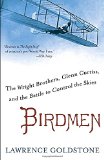Summary | Excerpt | Reviews | Beyond the Book | Readalikes | Genres & Themes | Author Bio
The Wright Brothers, Glenn Curtiss, and the Battle to Control the Skies

Critics' Opinion:
Readers' Opinion:
First Published:
May 2014, 448 pages
Paperback:
Apr 2015, 448 pages
 Book Reviewed by:
Book Reviewed by:
Poornima Apte
Buy This Book
Curtiss, who often spoke of his "speed craving," first turned his attention to propulsion. He experimented with motorizing bicycles and in January 1907 set a one-mile speed record of 136.7 miles per hour, for which he was hailed as the fastest man on earth; two years later, he would also be the fastest man aloft. By the time the Wrights, after a three-year delay, finally decided to aggressively market their invention, Curtiss was engineering the most efficient motors in the world. That he would mount those motors on aircraft created a threat to the Wrights' aspirations of monopoly and they brought suit to stifle the upstart. Although the Wrights never ceased to insist that their unrelenting pursuit of Curtiss was a moral issue, it was, as is virtually all such litigation, about money.
But for all the maneuvering and legal gamesmanship, the Wright–Curtiss feud was at its core a study of the unique strengths and flaws of personality that define a clash of brilliant minds. Neither Glenn Curtiss nor Wilbur Wright ever came to understand his own limits, that luminescent intelligence in one area of human endeavor does not preclude gross incompetence in another. And because genius often begets or even requires arrogance, both men continuously repeated their blunders.
Wilbur Wright and Glenn Curtiss might have been the principal players in this tableau, but they were hardly the only ones. Early flyers - "Birdmen," as they were called — were pioneers, heeding the same draw to riches or fame or illumination of the unknown that motivated those who had crossed uncharted oceans centuries before, and so aviation was replete with outsized personalities, brutal competition, and staggering bravery. There were great designers such as Louis Bleriot, who flew across the English Channel, the first man to do so, with a foot so badly burned that he had to be lifted in and out of his seat; Thomas Scott Baldwin, "Cap't Tom," inventor of the flexible parachute and incomparable showman, who almost convinced the world that balloons were the future of aviation; John Moisant, who after three failed attempts to overthrow the government of El Salvador took to aviation and within months became the preeminent flyer in the world; Harriet Quimby, an actress and journalist who cajoled flying lessons from her employer to become the first woman to receive a pilot's license and then the first to cross the English Channel; and Glenn Curtiss's most famous flyer, Lincoln Beachey, perhaps the finest aviator the world has ever seen, a man who boasted so many "firsts," "bests," and "never before dones" that his exploits would beggar credibility had they not all been documented by eyewitnesses.
The saga of the Wrights and Curtiss is the story of early flight. There was no one and nothing in the remarkable decade of 1905 to 1915 that one or both of them did not touch or affect. Their drama was played out on a stage populated by incomparable characters engaged in a pursuit that had held humankind in its thrall from the dawn of civilization.
CHAPTER 1
Fulcrum
On August 9, 1896, a wealthy German engineer named Otto Lilienthal hiked up a hill in Rhinow, thirty miles from his home in Berlin. At the top, he crawled under an odd-looking apparatus, braced himself against a specially designed frame, and stood up wearing a set of wooden-framed fabric wings that measured thirty feet across. He paused at the crest of the incline, made certain of the direction of the wind, took a deep breath, and then began to run down.
To a casual observer, Lilienthal would have made a ridiculous sight: another harebrained amateur convinced that man could achieve flight by pretending to be a bird. Surely, he would end his run with a face full of dirt, perhaps a broken bone or two.
But Otto Lilienthal was no amateur. He was, rather, the most sophisticated aerodynamicist of his day. For thirty years, he had taken tens of thousands of measurements of variously shaped surfaces moving at different angles through the air using a "whirling arm," a long pole that extended horizontally from a fixed vertical pole and spun at a preset velocity, a device originally developed to test the flight of cannonballs. In 1889, Lilienthal had produced the most advanced study ever written on the mechanics of flight, Der Vogelflug als Grundlage der Fliegekunst—"Bird-flight as the Basis of Aviation." As Wilbur Wright would later assert, "Of all the men who attacked the flying problem in the nineteenth century, Otto Lilienthal was easily the most important. His greatness appeared in every phase."
Excerpted from Birdmen by Lawrence Goldstone. Copyright © 2014 by Lawrence Goldstone. Excerpted by permission of Ballantine Books. All rights reserved. No part of this excerpt may be reproduced or reprinted without permission in writing from the publisher.





The Flower Sisters
by Michelle Collins Anderson
From the new Fannie Flagg of the Ozarks, a richly-woven story of family, forgiveness, and reinvention.

The House on Biscayne Bay
by Chanel Cleeton
As death stalks a gothic mansion in Miami, the lives of two women intertwine as the past and present collide.

The Funeral Cryer by Wenyan Lu
Debut novelist Wenyan Lu brings us this witty yet profound story about one woman's midlife reawakening in contemporary rural China.
Your guide toexceptional books
BookBrowse seeks out and recommends the best in contemporary fiction and nonfiction—books that not only engage and entertain but also deepen our understanding of ourselves and the world around us.